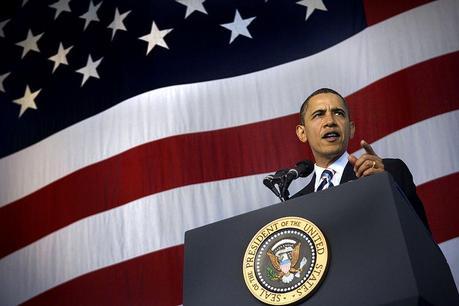
Image management is essential to getting elected President of the United States. In order to get the most out of the mass media spotlight, campaigns have taken to staging events and creating news in order to shape coverage in the direction they prefer (Dense “Media and Elections” Lecture). Political consultants even use polls and focus groups to discover the proper language to use when framing their candidate’s public agenda (Dionne, Mann). Despite these less than savory trends, a more important and positive change in campaign advertising is the utilization of social media and networking to bypass the mass media channels and connect directly with voters. This change has been driven by the migration of media consumption habits, making target audiences more difficult to reach through the mass media (Bennett 78). The addition of social media and digital participation to the electoral landscape mutes the impact of the other less positive changes in campaign advertising equaling a net benefit for democracy. The decentralization of media makes the electoral process more democratic.
In the 2008 Presidential election Barack Obama won a “digital landslide” (“The Digital President”). He out scored John McCain by two to one for the most viewed of online media content. Obama had 112 million subscribers to his YouTube channel, while McCain only had 25 million. The millennial generation of 18-25 year olds became very engaged with the Obama campaign through social networking sites, viral videos, and text messaging. An incredible 57% of citizens in this young demographic felt that these new tools of communication were the factor that kept them involved. Much of the digital network of Obama supporters on the web had only loose affiliations with the campaign and demonstrated authentic grass roots participation in the election process (“The Digital President”). The need to successfully tap into social media illustrates a move to campaign strategies that are more democratic due to their inclusiveness and decentralization.
Mass media and television news still play an essential role in the electoral process, and a modern trend with less egalitarian tendencies than social media is the use of strategic communications in order to manage the media. Message shaping, salience, credibility, and framing are the tools used to handle the media with the goal creating an image of the candidate that the campaign wants the public to perceive (Bennett 120). The media’s role of providing an experiential window on the candidates for the benefit of democracy can thus be transformed into that of the image creator (Dense “Media and Elections” Lecture). Obama benefited from the most positive coverage ever for any presidential nominee on the networks, with 68% positive appraisals by commentators (“Election Watch”). This has led to a suspicion of liberal media bias. However, a better explanation is that Obama was able to frame his campaign around the positive, yet generic messages, of “hope”, “change”, and “yes we can” (Will.i.am, Dylan). If a politician is successful in framing an issue, he can claim it (Jackson 47). This message also resonated through social media as well, suggesting that some of this framing was in fact passed along democratically.
Even with the democratic nature of social media, misleading information can be disseminated and spread, but the internet’s utility as a fact checker should counterbalance that. So an essential reform is the institution of strict transparency requirements. Currently, 501(C) groups are able to operate without the requirement to disclose who they receive donations from and how they spend this money, even though corporations and unions are allowed to make unlimited contributions to them (Dense “Stealth PACs” Lecture). Even though the Supreme Court has recently ruled that unlimited corporate and union expenditures on political messaging falls under the category of constitutionally protected free speech (Liptak), this presumably does not extend to a privilege of secrecy in this regard. With transparency in place, the democratic nature of social media has the potential to neutralize the effects of expensive mass media marketing efforts.
My own perspective on politics has changed dramatically in the last decade due to my interaction with new media tools. During the 2008 campaign I was an active participant in the Ron Paul campaign. Although I first learned of Paul through his rare appearances on mass media, I became much more enthusiastic through participation with the campaign through social media. I signed up for his email list, joined MeetUp groups, watched YouTube videos, made online donations, and ordered campaign materials from the web. This ultimately led me to direct involvement as an Alternate Delegate to the Washington State Republican Convention, which I could not envision happening without my online associations. I intend to investigate and participate in future campaigns through self-mediated tools online as well. Democracy is strengthened by the emergence of campaign advertising strategies that rely on the spontaneous networking power of citizens in order to achieve success.
Jared Roy Endicott

Works Cited
Bagdikian, Ben H..The New Media Monopoly. Updated and Revised Ed. Boston: Beacon Press Books, 2004. Print.
Bennett, W. Lance. News: The Politics of Illusion. Eighth Ed. New York: Pearson Education, Inc., 2009. Print.
Dionne Jr., E.J., and Thomas E. Mann. “Polling & Public Opinion.” The Brookings Institute. Sum. 2003. Web. 8 Feb 2010.
“Election Watch: Campaign 2008 Final.” Media Monitor, Center for Public Media. Win. 2009. Web. 8 Feb 2010.
Liptak, Adam. “Justices, 5-4, Reject Corporate Spending Limits.” The New York Times, NYTimes.com. 21 Jan. 2010. Web. 15 Feb 2010.
Jackson, Brooks, and Kathleen Hall Jamieson. Un-Spun: Finding Facts in a World of Disinformation. New York: Random House Trade Paperbacks, 2007. Print.
“The Digital President Part 1.” UW Insight, YouTube.com. Jan. 2009. Web. 11 Feb 2010.
Will.i.am, and Jesse Dylan. “Yes We Can.” The Living Room Candidate. 2008. Web. 14 Feb 2010.

